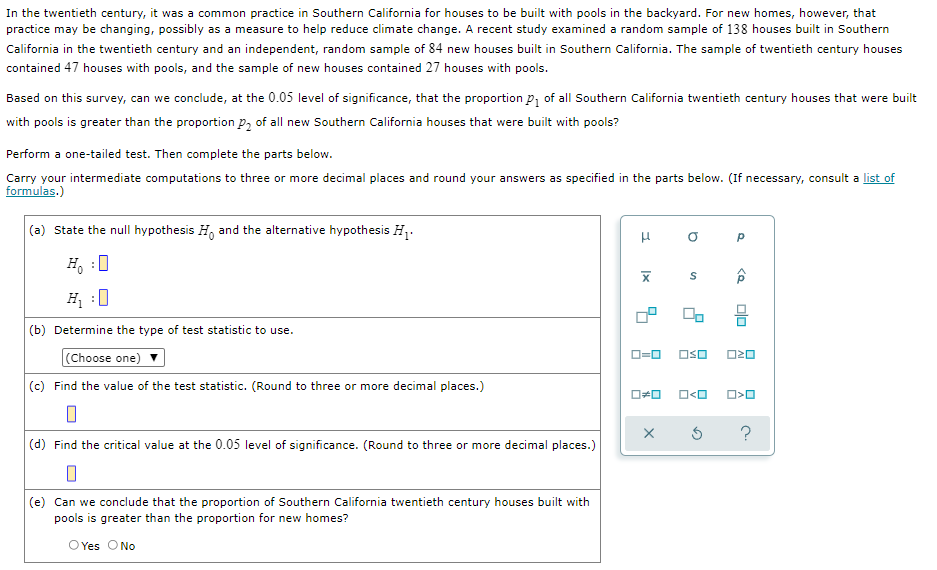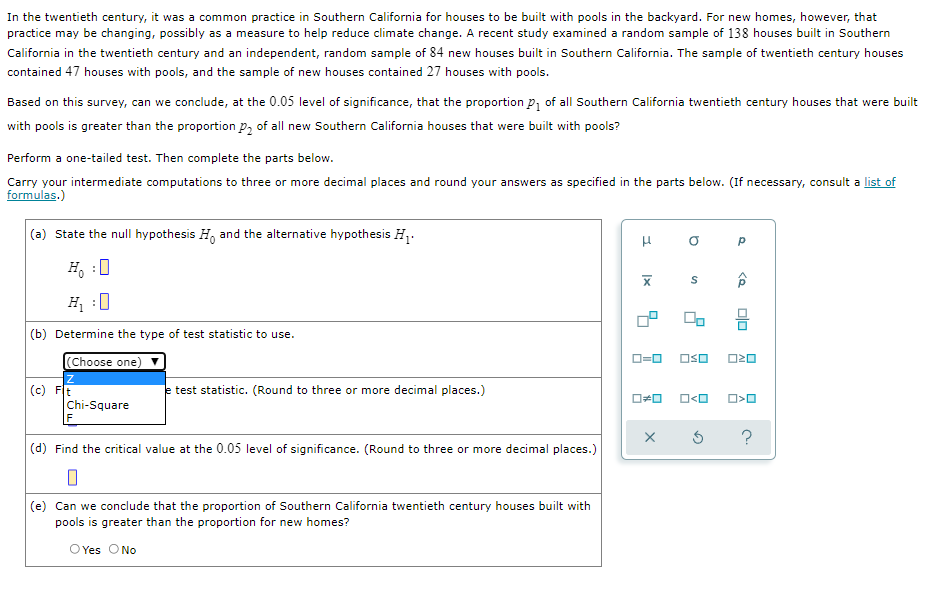In the twentieth century, it was a common practice in Southern California for houses to be built with pools in the backyard. For néw homes, however, that practice may be changing, possibly as a measure to help reduce climate change. A recent study examined a random sample of 138 houses built in Southern California in the twentieth century and an independent, random sample of 84 new houses built in Southern California. The sample of twentieth century house contained 47 houses with pools, and the sample of new houses contained 27 houses with pools. Based on this survey, can we conclude, at the 0.05 level of significance, that the proportion p, of all Southern California twentieth century houses that were with pools is greater than the proportion p2 of all new Southern California houses that were built with pools? Perform a one-tailed test. Then complete the parts below. Carry your intermediate computations to three or more decimal places and round your answers as specified in the parts below. (If necessary, consult a list o formulas.) |(a) State the null hypothesis H, and the alternative hypothesis H1. H, :0 |(b) Determine the type of test statistic to use. Dlo
In the twentieth century, it was a common practice in Southern California for houses to be built with pools in the backyard. For néw homes, however, that practice may be changing, possibly as a measure to help reduce climate change. A recent study examined a random sample of 138 houses built in Southern California in the twentieth century and an independent, random sample of 84 new houses built in Southern California. The sample of twentieth century house contained 47 houses with pools, and the sample of new houses contained 27 houses with pools. Based on this survey, can we conclude, at the 0.05 level of significance, that the proportion p, of all Southern California twentieth century houses that were with pools is greater than the proportion p2 of all new Southern California houses that were built with pools? Perform a one-tailed test. Then complete the parts below. Carry your intermediate computations to three or more decimal places and round your answers as specified in the parts below. (If necessary, consult a list o formulas.) |(a) State the null hypothesis H, and the alternative hypothesis H1. H, :0 |(b) Determine the type of test statistic to use. Dlo
Holt Mcdougal Larson Pre-algebra: Student Edition 2012
1st Edition
ISBN:9780547587776
Author:HOLT MCDOUGAL
Publisher:HOLT MCDOUGAL
Chapter11: Data Analysis And Probability
Section: Chapter Questions
Problem 8CR
Related questions
Question

Transcribed Image Text:In the twentieth century, it was a common practice in Southern California for houses to be built with pools in the backyard. For new homes, however, that
practice may be changing, possibly as a measure to help reduce climate change. A recent study examined a random sample of 138 houses built in Southern
California in the twentieth century and an independent, random sample of 84 new houses built in Southern California. The sample of twentieth century houses
contained 47 houses with pools, and the sample of new houses contained 27 houses with pools.
Based on this survey, can we conclude, at the 0.05 level of significance, that the proportion P, of all Southern California twentieth century houses that were built
with pools is greater than the proportion p, of all new Southern California houses that were built with pools?
Perform a one-tailed test. Then complete the parts below.
Carry your intermediate computations to three or more decimal places and round your answers as specified in the parts below. (If necessary, consult a list of
formulas.)
(a) State the null hypothesis H, and the alternative hypothesis H1.
H, :0
H :0
(b) Determine the type of test statistic to use.
(Choose one)
D=0
OSO
O20
(c) Find the value of the test statistic. (Round to three or more decimal places.)
O<O
?
(d) Find the critical value at the 0.05 level of significance. (Round to three or more decimal places.)
(e) Can we conclude that the proportion of Southern California twentieth century houses built with
pools is greater than the proportion for new homes?
O Yes ONo

Transcribed Image Text:In the twentieth century, it was a common practice in Southern California for houses to be built with pools in the backyard. For new homes, however, that
practice may be changing, possibly as a measure to help reduce climate change. A recent study examined a random sample of 138 houses built in Southern
California in the twentieth century and an independent, random sample of 84 new houses built in Southern California. The sample of twentieth century houses
contained 47 houses with pools, and the sample of new houses contained 27 houses with pools.
Based on this survey, can we conclude, at the 0.05 level of significance, that the proportion p, of all Southern California twentieth century houses that were built
with pools is greater than the proportion p, of all new Southern California houses that were built with pools?
Perform a one-tailed test. Then complete the parts below.
Carry your intermediate computations to three or more decimal places and round your answers as specified in the parts below. (If necessary, consult a list of
formulas.)
(a) State the null hypothesis H, and the alternative hypothesis H,.
H, :0
H, :0
믐
(b) Determine the type of test statistic to use.
Choose one)
O=0
OSO
(c) Ft
test statistic. (Round to three or more decimal places.)
O<O
Chi-Square
(d) Find the critical value at the 0.05 level of significance. (Round to three or more decimal places.)
(e) Can we conclude that the proportion of Southern California twentieth century houses built with
pools is greater than the proportion for new homes?
OYes ONo
Expert Solution
This question has been solved!
Explore an expertly crafted, step-by-step solution for a thorough understanding of key concepts.
This is a popular solution!
Trending now
This is a popular solution!
Step by step
Solved in 2 steps

Recommended textbooks for you

Holt Mcdougal Larson Pre-algebra: Student Edition…
Algebra
ISBN:
9780547587776
Author:
HOLT MCDOUGAL
Publisher:
HOLT MCDOUGAL

College Algebra (MindTap Course List)
Algebra
ISBN:
9781305652231
Author:
R. David Gustafson, Jeff Hughes
Publisher:
Cengage Learning


Holt Mcdougal Larson Pre-algebra: Student Edition…
Algebra
ISBN:
9780547587776
Author:
HOLT MCDOUGAL
Publisher:
HOLT MCDOUGAL

College Algebra (MindTap Course List)
Algebra
ISBN:
9781305652231
Author:
R. David Gustafson, Jeff Hughes
Publisher:
Cengage Learning
